Your cart is currently empty!
Tag: daily prompt
-
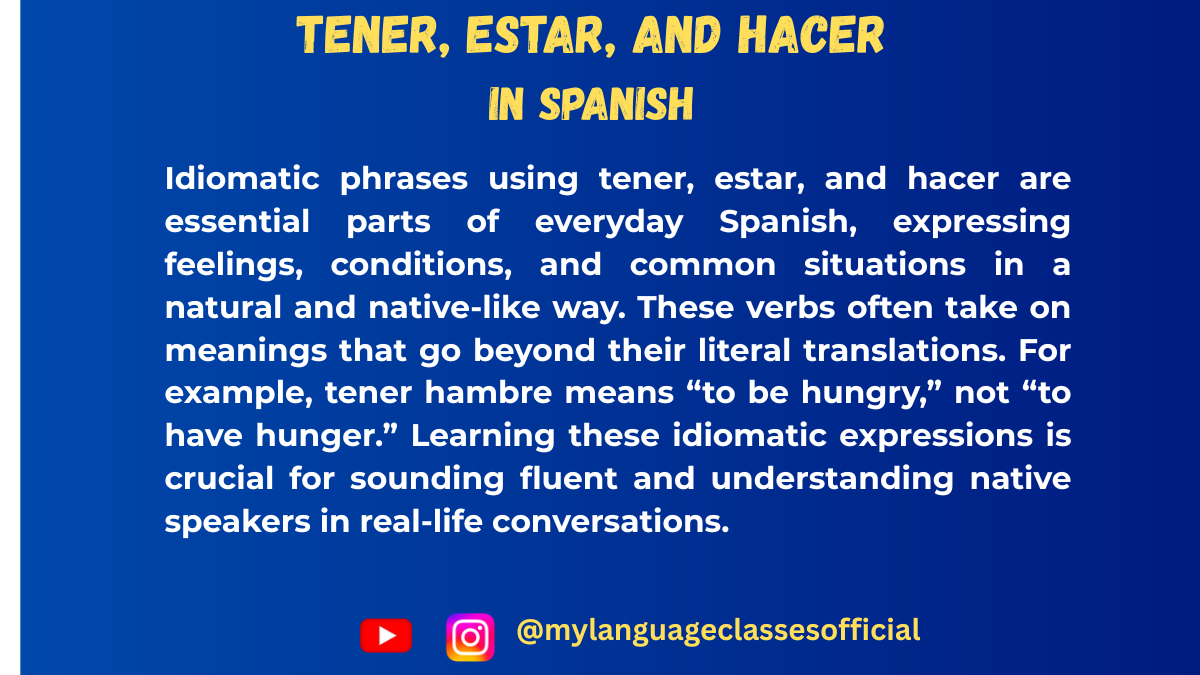
Idiomatic Phrases Using Tener, Estar, and Hacer in Spanish
Mastering idiomatic expressions is essential for achieving fluency in Spanish. Many common expressions in Spanish use the verbs tener (to have), estar (to be), and hacer (to do/make), which often don’t translate literally into English. In this blog, we will explore frequently used phrases such as tener razón, tener ganas de, estar de acuerdo, and many others, along with their meanings, uses, and examples.
Understanding Tener, Estar, and Hacer in Idiomatic Expressions
In Spanish, some expressions that involve states, desires, or idiomatic ideas use tener, estar, or hacer, instead of ser or other verbs we might expect in English.
- Tener is often used for conditions, feelings, or necessity.
- Estar is used for temporary states, emotions, and agreements.
- Hacer is commonly used for weather expressions and actions.
To form these idiomatic phrases, we follow these patterns:
✅ Tener + noun → (e.g., tener razón – “to be right”)
✅ Estar + prepositional phrase/adjective → (e.g., estar de acuerdo – “to agree”)
✅ Hacer + noun → (e.g., hacer frío – “to be cold (weather-wise)”)
Common Expressions Using Tener, Estar, and Hacer
Here is a list of beginner and intermediate-level expressions along with their meanings and example sentences.
Expression Meaning Example 1 Example 2 Tener hambre To be hungry Tengo hambre, ¿puedo comer algo? (I am hungry, can I eat something?) Los niños tienen hambre después de jugar. (The children are hungry after playing.) Tener sed To be thirsty Después de correr, siempre tengo mucha sed. (After running, I am always very thirsty.) ¿Tienes sed? Hay agua en la nevera. (Are you thirsty? There is water in the fridge.) Tener razón To be right Tienes razón, era una mala idea. (You are right, it was a bad idea.) El profesor tenía razón sobre la respuesta. (The teacher was right about the answer.) Tener ganas de + infinitive To feel like (doing something) Tengo ganas de viajar a España. (I feel like traveling to Spain.) No tengo ganas de salir hoy. (I don’t feel like going out today.) Tener cuidado To be careful ¡Ten cuidado con el perro! (Be careful with the dog!) Debes tener cuidado al cruzar la calle. (You must be careful when crossing the street.) Tener sueño To be sleepy Después de estudiar, tengo mucho sueño. (After studying, I am very sleepy.) Ella siempre tiene sueño por la mañana. (She is always sleepy in the morning.) Estar de acuerdo To agree Estoy de acuerdo contigo. (I agree with you.) Mis padres no están de acuerdo con mi decisión. (My parents do not agree with my decision.) Estar de buen/mal humor To be in a good/bad mood Hoy estoy de buen humor. (Today I am in a good mood.) Después del examen, estaba de mal humor. (After the exam, I was in a bad mood.) Hacer frío/calor To be cold/hot (weather) Hace mucho frío en invierno. (It is very cold in winter.) En la playa, hace calor. (At the beach, it is hot.) Hacer falta To be necessary/to need Hace falta estudiar para el examen. (It is necessary to study for the exam.) Nos hace falta más información. (We need more information.)
More Example Sentences
- Hace mucho viento hoy. (It is very windy today.)
- Tienes razón, esto no es fácil. (You are right, this is not easy.)
- No estoy de acuerdo con esa idea. (I do not agree with that idea.)
- Hace falta paciencia para aprender un idioma. (Patience is necessary to learn a language.)
- Ten cuidado, la carretera está resbaladiza. (Be careful, the road is slippery.)
- Siempre tengo ganas de comer pizza los viernes. (I always feel like eating pizza on Fridays.)
- Mi hermana tiene sueño porque estudió hasta tarde. (My sister is sleepy because she studied late.)
- En verano hace mucho calor en mi ciudad. (In summer, it is very hot in my city.)
- Después del trabajo, mi madre siempre está de buen humor. (After work, my mom is always in a good mood.)
- Los estudiantes no están de acuerdo con las nuevas reglas. (The students do not agree with the new rules.)
Fill in the Blanks
- ______ cuidado cuando cruzas la calle.
- Después de correr, ______ sed.
- ¿Tú ______ de acuerdo con esa decisión?
- Esta sopa está caliente, ______ falta más agua fría.
- En invierno ______ frío, así que uso un abrigo.
- Hoy no ______ ganas de salir.
- Mi hermana siempre ______ sueño por la mañana.
- Tú siempre ______ razón en las discusiones.
- Mis amigos y yo ______ de buen humor porque es viernes.
- ¡______ falta estudiar más para el examen!
Answers:
- Ten
- Tengo
- Estás
- Hace
- Hace
- Tengo
- Tiene
- Tienes
- Estamos
- Hace
Things to Keep in Mind
- Tener expressions use a noun, meaning they follow gender and number rules. Example: Tener hambre (hunger, feminine noun) vs. Tener ganas de (desires, plural noun).
- Estar expressions often use prepositional phrases such as de acuerdo or de buen humor.
- Hacer expressions are commonly used for weather, e.g., Hace frío instead of Es frío.
- Some phrases change based on the subject. Example: Tengo ganas de comer (I feel like eating) vs. Tenemos ganas de viajar (We feel like traveling).
Conclusion
Using idiomatic expressions with tener, estar, and hacer correctly will make your Spanish sound more natural and fluent. These phrases often don’t translate directly into English, so understanding their structure and use in different contexts is essential. Keep practicing these expressions in daily conversations to improve your fluency and confidence in Spanish!
If you enjoyed this lesson, be sure to check out more posts like this on my blog at My Language Classes. Don’t forget to subscribe my YouTube channel and follow me on Instagram for the latest language learning tips and lessons. Leave a comment below to share your thoughts, or ask any questions you have.
Happy learning! 😊
-
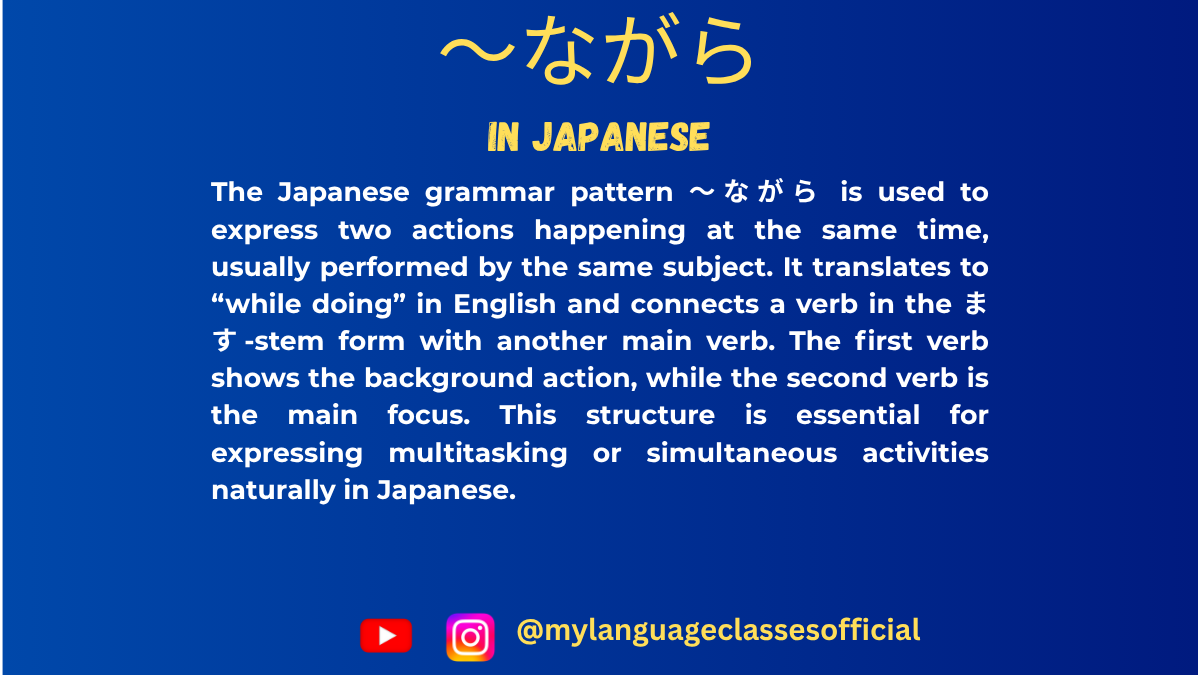
Using 〜ながら Form in Japanese | My Language Classes
〜ながら Form in Japanese
The 〜ながら (nagara) form is an essential Japanese grammar structure used to describe two actions happening simultaneously. It is widely used in both casual and formal conversations to indicate multitasking or actions occurring at the same time.
In this blog, we will explore the formation of 〜ながら for all three verb groups, its various usages, and a comprehensive list of verbs with example sentences. Additionally, we will provide a section with more example sentences, fill-in-the-blank exercises, key points to remember, and a conclusion.
Formation of 〜ながら for Different Verb Groups
Japanese verbs are categorized into three groups: Group 1 (Godan verbs), Group 2 (Ichidan verbs), and Group 3 (Irregular verbs). Each group follows a specific rule for forming 〜ながら.
1. Group 1 (Godan Verbs)
For Godan verbs, take the ます-stem of the verb and add ながら.
- Example Formation
- 話す (hanasu – to speak) → 話しながら (hanashinagara – while speaking)
- 書く (kaku – to write) → 書きながら (kakinagara – while writing)
2. Group 2 (Ichidan Verbs)
For Ichidan verbs, remove る from the dictionary form and add ながら.
- Example Formation
- 食べる (taberu – to eat) → 食べながら (tabenagara – while eating)
- 見る (miru – to see) → 見ながら (minagara – while watching)
3. Group 3 (Irregular Verbs)
There are only two irregular verbs in Japanese: する and くる.
- Example Formation
- する (suru – to do) → しながら (shiinagara – while doing)
- くる (kuru – to come) → きながら (kinagara – while coming)
Situations Where 〜ながら Form is Used
- Describing Two Simultaneous Actions
- 音楽を聞きながら勉強する (Ongaku o kikinagara benkyou suru) – Study while listening to music.
- Multitasking in Daily Life
- テレビを見ながらご飯を食べる (Terebi o minagara gohan o taberu) – Eat while watching TV.
- Speaking While Performing Another Action
- 笑いながら話す (Warainagara hanasu) – Talk while laughing.
- Contrasting Two Simultaneous Actions
- 悲しみながら笑う (Kanashiminagara warau) – Laugh while feeling sad.
- Working or Performing a Task While Doing Something Else
- 仕事をしながらコーヒーを飲む (Shigoto o shinagara koohii o nomu) – Drink coffee while working.
Verb List with 〜ながら Form and Example Sentences
Verb (Dictionary Form) 〜ながら Form Example Sentence (Japanese) Romaji English Translation 話す (hanasu) 話しながら (hanashinagara) 彼は笑いながら話しました。 Kare wa warainagara hanashimashita. He spoke while laughing. 書く (kaku) 書きながら (kakinagara) 先生は黒板に書きながら説明した。 Sensei wa kokuban ni kakinagara setsumei shita. The teacher explained while writing on the board. 読む (yomu) 読みながら (yominagara) 彼女は本を読みながら寝てしまった。 Kanojo wa hon o yominagara nete shimatta. She fell asleep while reading a book. 見る (miru) 見ながら (minagara) 子供たちはアニメを見ながら笑った。 Kodomotachi wa anime o minagara waratta. The children laughed while watching anime. 歩く (aruku) 歩きながら (arukinagara) 彼は音楽を聞きながら歩いた。 Kare wa ongaku o kikinagara aruita. He walked while listening to music. 食べる (taberu) 食べながら (tabenagara) 彼女はテレビを見ながら食べる。 Kanojo wa terebi o minagara taberu. She eats while watching TV. 泳ぐ (oyogu) 泳ぎながら (oyoginagara) 彼は海で泳ぎながら歌った。 Kare wa umi de oyoginagara utatta. He sang while swimming in the sea.
More Example Sentences
- 音楽を聞きながら勉強する。
Ongaku o kikinagara benkyou suru.
Study while listening to music. - コーヒーを飲みながらニュースを見る。
Koohii o nominagara nyuusu o miru.
Watch the news while drinking coffee. - 料理をしながらラジオを聞く。
Ryouri o shinagara rajio o kiku.
Listen to the radio while cooking. - 車を運転しながら歌う。
Kuruma o unten shinagara utau.
Sing while driving. - 宿題をしながら電話をする。
Shukudai o shinagara denwa o suru.
Talk on the phone while doing homework.
Fill in the Blanks Questions
- 本を______ながら、リラックスします。(読む)
- 音楽を______ながら、運転する。(聞く)
- 仕事を______ながら、テレビを見る。(する)
- ご飯を______ながら、友達と話す。(食べる)
- 日本語を______ながら、メモを取る。(勉強する)
Answers
- 読みながら (yominagara)
- 聞きながら (kikinagara)
- しながら (shiinagara)
- 食べながら (tabenagara)
- 勉強しながら (benkyou shinagara)
Things to Keep in Mind
- The subject of both actions must be the same.
- The ながら clause comes before the main action.
- ながら is used only for actions, not states.
Conclusion
The 〜ながら form is an important grammar structure in Japanese that allows smooth expression of simultaneous actions. By practicing with various verbs and sentences, you will become more fluent in using it naturally in conversations.
Keep practicing and incorporating 〜ながら into your daily Japanese studies!
If you enjoyed this lesson, be sure to check out more posts like this on my blog at My Language Classes. Don’t forget to subscribe my YouTube channel and follow me on Instagram for the latest language learning tips and lessons. Leave a comment below to share your thoughts, or ask any questions you have about nouns.
Happy learning! 😊
- Example Formation
-
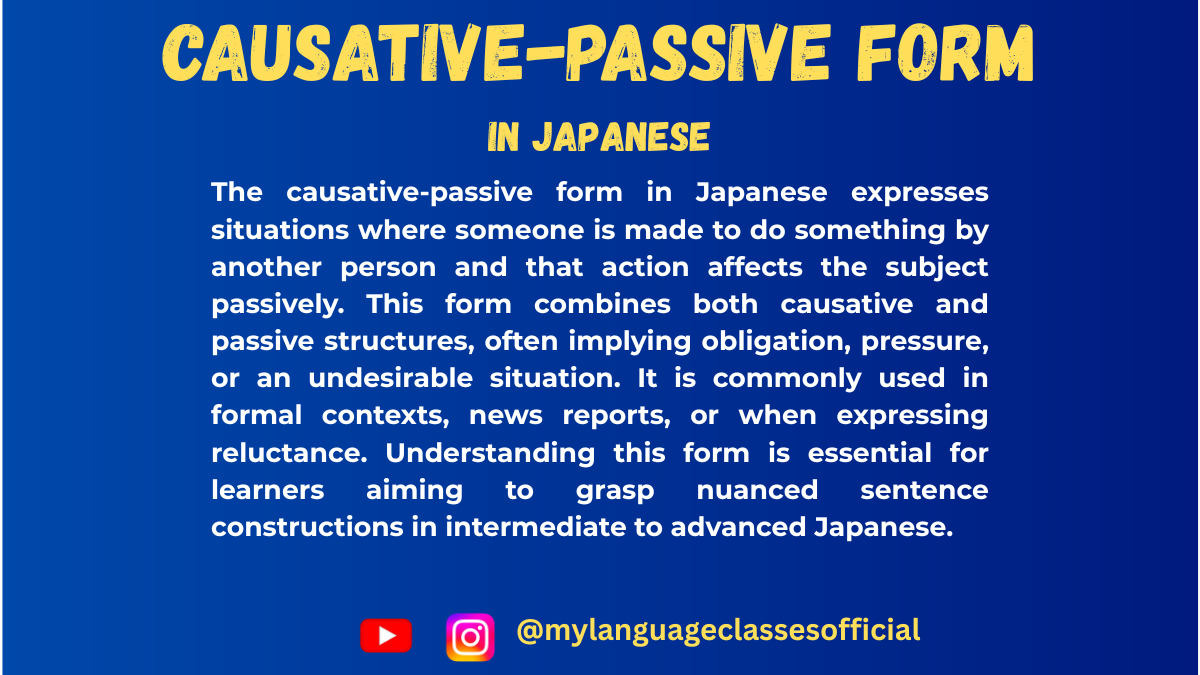
Causative-Passive Form of verbs in Japanese | My Language Classes
Causative-Passive Form in Japanese
The causative-passive form (使役受身, shieki ukemi) in Japanese is an important grammatical structure that conveys a sense of being forced or made to do something against one’s will. This form is frequently used in formal speech, written language, and storytelling.
Formation of Causative-Passive Verbs
To form the causative-passive form, we first conjugate the verb into its causative form and then change it into its passive form.
Group 1 (Ichidan) Verbs
- Convert the verb to its causative form:
- Drop る and add させる (for positive causative)
- Convert the causative form to its passive form:
- Drop る and add られる
Example:
- 食べる (たべる, taberu) → 食べさせる (たべさせる, tabesaseru) → 食べさせられる (たべさせられる, tabesaserareru)
Group 2 (Godan) Verbs
- Convert the verb to its causative form:
- Change the u sound to a and add せる
- Convert the causative form to its passive form:
- Change せる to せられる or される
Example:
- 書く (かく, kaku) → 書かせる (かかせる, kakaseru) → 書かせられる (かかせられる, kakaserareru)
Group 3 (Irregular) Verbs
- する → させる → させられる
- くる → こさせる → こさせられる
Usage of the Causative-Passive Form
The causative-passive form is primarily used in the following situations:
- Expressing Forced Action
- “I was made to do something.”
- Indicating an Unwanted Situation
- “I ended up in an unfavorable situation.”
- In Formal Writing & Passive Expressions
- Commonly used in news articles, literature, and business settings.
- Indirect Authority or Control
- Used when talking about school, work, or hierarchical relationships.
- Apologizing or Explaining a Difficult Situation
- “I was put in a tough spot.”
List of Causative-Passive Verbs with Examples
Verb Causative-Passive Form Example Sentence 1 Romaji English Meaning Example Sentence 2 Romaji English Meaning 書く (kaku) 書かせられる (kakaserareru) 先生に作文を書かせられた。 Sensei ni sakubun o kakaserareta. I was forced to write an essay by the teacher. 上司にレポートを書かせられた。 Joushi ni repooto o kakaserareta. I was made to write a report by my boss. 食べる (taberu) 食べさせられる (tabesaserareru) 嫌いな野菜を食べさせられた。 Kirai na yasai o tabesaserareta. I was made to eat vegetables I dislike. 子供のころ、嫌いな魚を食べさせられた。 Kodomo no koro, kirai na sakana o tabesaserareta. When I was a child, I was made to eat fish I disliked. 話す (hanasu) 話させられる (hanasaserareru) 上司に長いスピーチを話させられた。 Joushi ni nagai supiichi o hanasaserareta. I was made to give a long speech by my boss. 友達に嘘を話させられた。 Tomodachi ni uso o hanasaserareta. I was forced to tell a lie by my friend. 読む (yomu) 読まさせられる (yomasaserareru) 先生に長い本を読まさせられた。 Sensei ni nagai hon o yomasaserareta. I was forced to read a long book by the teacher. 上司に新聞を読まさせられた。 Joushi ni shinbun o yomasaserareta. I was made to read the newspaper by my boss. 行く (iku) 行かさせられる (ikasaserareru) 先生に学校に行かさせられた。 Sensei ni gakkou ni ikasaserareta. I was made to go to school by the teacher. 父に病院に行かさせられた。 Chichi ni byouin ni ikasaserareta. I was forced to go to the hospital by my father. More Example Sentences
- 先生に漢字を100回書かせられた。
Sensei ni kanji o hyakkai kakaserareta.
I was forced to write kanji 100 times by the teacher. - 母に部屋を掃除させられた。
Haha ni heya o souji saserareta.
I was made to clean my room by my mother. - 部長に遅くまで働かさせられた。 Buchou ni osoku made hatarakasaserareta. I was made to work late by my manager.
- 先生に難しい問題を解かさせられた。 Sensei ni muzukashii mondai o tokasaserareta. I was forced to solve a difficult problem by the teacher.
- 親に謝らさせられた。 Oya ni ayamarasaserareta. I was made to apologize by my parents.
Conclusion
The causative-passive form is a useful grammatical structure for expressing situations where someone is forced to act against their will. While it is more common in written and formal contexts, mastering this form will greatly enhance your Japanese comprehension and expression skills. Keep practicing with different verbs and real-life situations to fully grasp the nuances of this construction!
If you enjoyed this lesson, be sure to check out more posts like this on my blog at My Language Classes. Don’t forget to subscribe my YouTube channel and follow me on Instagram for the latest language learning tips and lessons. Leave a comment below to share your thoughts, or ask any questions you have about nouns.
Happy learning! 😊
- Convert the verb to its causative form:
-

Time Expressions in Spanish: Hace + Time + Que, Desde, Desde Hace, and More
When learning Spanish, mastering time expressions is crucial for effective communication. Expressions like hace + time + que, desde, and desde hace help describe durations, points in time, and ongoing actions. In this blog post, we’ll explore these expressions in detail, provide examples, and offer practice exercises.
Common Spanish Time Expressions
Below is a list of commonly used time expressions in Spanish, their meanings, and example sentences:
Time Expression Meaning Example 1 Example 2 Hace + time + que “It has been (time) since…” Hace dos horas que estudio. (I have been studying for two hours.) Hace un mes que vivo en Madrid. (I have been living in Madrid for a month.) Desde “Since (a point in time)” Vivo en Madrid desde 2020. (I have lived in Madrid since 2020.) No como carne desde enero. (I haven’t eaten meat since January.) Desde hace “For (a duration of time)” Trabajo aquí desde hace cinco años. (I have been working here for five years.) No veo a Juan desde hace meses. (I haven’t seen Juan for months.) Hace + time “(Time) ago” Fui a España hace tres años. (I went to Spain three years ago.) Terminó la tarea hace una hora. (He finished the homework an hour ago.) Llevar + time + gerundio “To have been (doing something) for (time)” Llevo dos años aprendiendo español. (I have been learning Spanish for two years.) Lleva tres horas esperando. (He has been waiting for three hours.) Hace tiempo que “It’s been a long time since…” Hace tiempo que no te veo. (I haven’t seen you in a long time.) Hace tiempo que no viajo. (I haven’t traveled in a long time.) Desde que “Since (something happened)” Desde que me mudé, estoy feliz. (Since I moved, I am happy.) Desde que empezó el curso, estudio más. (Since the course started, I study more.) Al cabo de “After (time period)” Al cabo de dos años, me fui. (After two years, I left.) Al cabo de un mes, nos casamos. (After a month, we got married.) En cuanto “As soon as” En cuanto llegué, comimos. (As soon as I arrived, we ate.) En cuanto lo vi, supe la verdad. (As soon as I saw him, I knew the truth.) More Example Sentences
- Hace cinco minutos que llegué. (I arrived five minutes ago.)
- No veo a mi primo desde hace tres semanas. (I haven’t seen my cousin for three weeks.)
- Estudio español desde el año pasado. (I have been studying Spanish since last year.)
- Desde que cambié de trabajo, soy más feliz. (Since I changed jobs, I am happier.)
- Llevo un mes sin fumar. (I haven’t smoked for a month.)
- Hace dos años que conozco a Marta. (I have known Marta for two years.)
- Al cabo de unos meses, aprendí a nadar. (After a few months, I learned to swim.)
- En cuanto terminó la reunión, salimos. (As soon as the meeting ended, we left.)
- Hace tiempo que no voy al cine. (I haven’t been to the cinema in a long time.)
- Desde que empezó la pandemia, trabajo desde casa. (Since the pandemic started, I have been working from home.)
Fill in the Blanks
Fill in the blanks with the correct time expression.
- _______ dos horas que espero tu llamada.
- No veo a mi amigo _______ un año.
- Trabajo en esta empresa _______ hace cinco años.
- _______ empezó el curso, estudio mucho más.
- Mi hermano llegó _______ tres días.
- _______ un mes que no salimos a cenar.
- Llevo dos meses _______ practicar yoga.
- _______ compré este coche, no he tenido problemas mecánicos.
- _______ lo vi, me di cuenta de su felicidad.
- Al cabo _______ un año, decidimos mudarnos.
Answers
- Hace
- Desde hace
- Desde hace
- Desde que
- Hace
- Hace
- Sin
- Desde que
- En cuanto
- de
Things to Keep in Mind
- Gender and Number: Some time expressions require agreement in gender and number. For example, Hace un mes (one month) but Hace dos meses (two months).
- Articles: Desde hace is often followed by a duration (e.g., Desde hace tres años). However, desde alone is used with specific dates or points in time (e.g., Desde 2020).
- Different Uses: Hace + time is used for the past (e.g., Hace un año que fui a España), while Desde hace emphasizes duration.
- Llevar + gerund: This expression is similar to hace + que but emphasizes ongoing action (e.g., Llevo dos años estudiando español).
Conclusion
Time expressions in Spanish are essential for discussing events, durations, and actions. Understanding the differences between hace + time + que, desde, and desde hace will help you communicate fluently. Practice using these expressions in different contexts to improve your Spanish skills!
If you enjoyed this lesson, be sure to check out more posts like this on my blog at My Language Classes. Don’t forget to subscribe my YouTube channel and follow me on Instagram for the latest language learning tips and lessons. Leave a comment below to share your thoughts, or ask any questions you have.
Happy learning! 😊
-
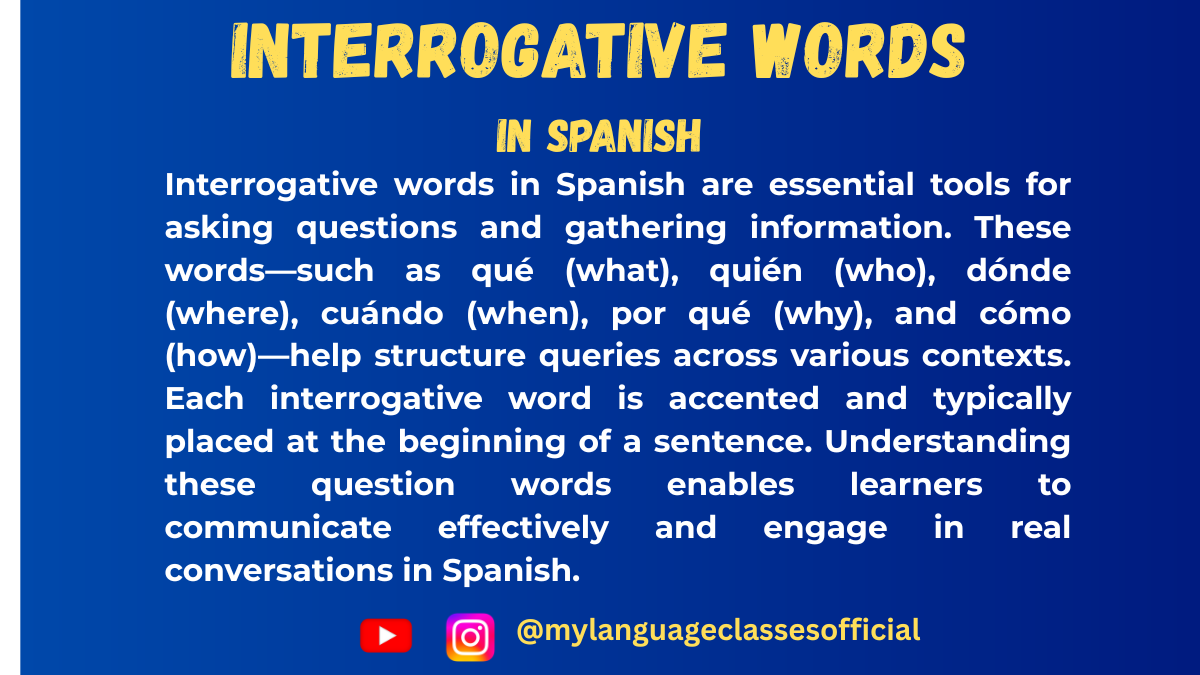
Questions with Interrogative Words in Spanish
Asking questions in Spanish is an essential skill for effective communication. Spanish has various interrogative words that help in forming questions. In this blog, we will cover common interrogative words such as “qué,” “quién,” “cuándo,” “dónde,” “por qué,” “cómo,” “cuánto,” and others. We will also explore their meanings, usage, and structure in different grammatical contexts.
Common Interrogative Words and Their Meanings
Below is a list of the most frequently used interrogative words in Spanish, along with their meanings:
Interrogative Word Meaning Qué What Quién Who Quiénes Who (plural) Cuándo When Dónde Where Por qué Why Cómo How Cuánto How much Cuánta How much (feminine) Cuántos How many (masculine) Cuántas How many (feminine) Cuál Which Cuáles Which (plural) How to Form Questions with Interrogative Words
- Sentence Structure: In Spanish, the interrogative word usually appears at the beginning of the question. The verb generally follows immediately after the interrogative word.
- Example: ¿Dónde está el libro? (Where is the book?)
- Use of Articles:
- In some cases, definite or indefinite articles are needed before the noun.
- Example: ¿Qué es el amor? (What is love?)
- Singular vs. Plural:
- “Cuánto” changes based on gender and number.
- Example: ¿Cuántos libros tienes? (How many books do you have?)
- Example: ¿Cuántas hermanas tienes? (How many sisters do you have?)
- Gender Agreement:
- Some interrogative words change based on gender.
- Example: ¿Cuánto dinero tienes? (How much money do you have?)
- Example: ¿Cuánta agua bebes? (How much water do you drink?)
Beginner and Intermediate Level Interrogative Words with Examples
Interrogative Word Example Sentence 1 Example Sentence 2 Qué ¿Qué quieres comer? (What do you want to eat?) ¿Qué es esto? (What is this?) Quién ¿Quién es él? (Who is he?) ¿Quién viene a la fiesta? (Who is coming to the party?) Cuándo ¿Cuándo es tu cumpleaños? (When is your birthday?) ¿Cuándo llegas? (When are you arriving?) Dónde ¿Dónde vives? (Where do you live?) ¿Dónde está mi mochila? (Where is my backpack?) Por qué ¿Por qué estás triste? (Why are you sad?) ¿Por qué estudias español? (Why do you study Spanish?) Cómo ¿Cómo estás? (How are you?) ¿Cómo funciona esto? (How does this work?) Cuánto ¿Cuánto cuesta? (How much does it cost?) ¿Cuánto tiempo tenemos? (How much time do we have?) More Example Sentences
- ¿Cuáles son tus colores favoritos? (Which are your favorite colors?)
- ¿Cuánta agua bebes al día? (How much water do you drink per day?)
- ¿Dónde compraste ese vestido? (Where did you buy that dress?)
- ¿Por qué no viniste ayer? (Why didn’t you come yesterday?)
- ¿Cómo llegaste aquí? (How did you get here?)
- ¿Qué tipo de música te gusta? (What type of music do you like?)
- ¿Cuándo comienza la película? (When does the movie start?)
- ¿Cuántos amigos tienes? (How many friends do you have?)
- ¿Cuál es tu comida favorita? (Which is your favorite food?)
- ¿Quiénes son esos niños? (Who are those kids?)
Fill in the Blanks
- ¿______ es tu profesor? (Who is your teacher?)
- ¿______ vives? (Where do you live?)
- ¿______ cuesta esta camisa? (How much does this shirt cost?)
- ¿______ vienes a la escuela? (When do you come to school?)
- ¿______ quieres comer? (What do you want to eat?)
- ¿______ estudias español? (Why do you study Spanish?)
- ¿______ hermanos tienes? (How many siblings do you have?)
- ¿______ estás? (How are you?)
- ¿______ son tus zapatos? (Which are your shoes?)
- ¿______ trabaja en esa oficina? (Who works in that office?)
Answers
- Quién 2. Dónde 3. Cuánto 4. Cuándo 5. Qué 6. Por qué 7. Cuántos 8. Cómo 9. Cuáles 10. Quién
Things to Keep in Mind
- Always use an accent (tílde) on interrogative words.
- Adjust the verb conjugation according to the subject.
- Ensure gender and number agreement.
- Some questions require context for clarity.
Conclusion
Mastering interrogative words in Spanish is key to effective communication. Practice these structures and soon, asking and answering questions in Spanish will become second nature!
If you enjoyed this lesson, be sure to check out more posts like this on my blog at My Language Classes. Don’t forget to subscribe my YouTube channel and follow me on Instagram for the latest language learning tips and lessons. Leave a comment below to share your thoughts, or ask any questions you have.
Happy learning! 😊
- Sentence Structure: In Spanish, the interrogative word usually appears at the beginning of the question. The verb generally follows immediately after the interrogative word.
-
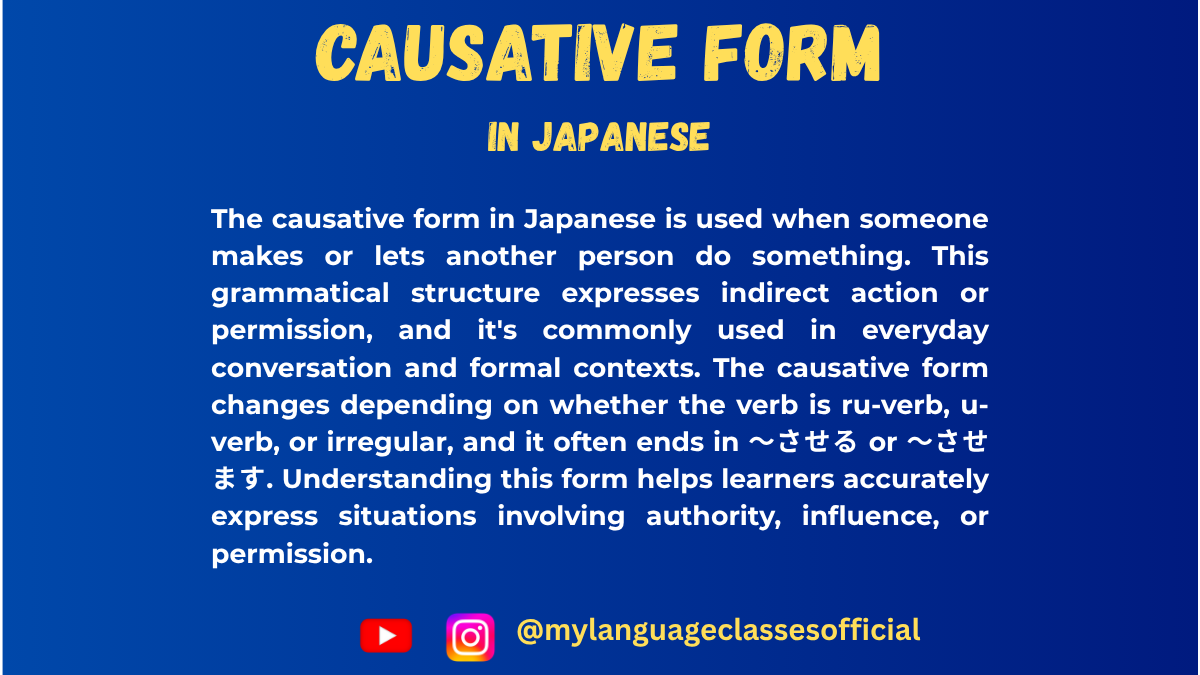
Causative Form of Verbs in Japanese | My Language Classes
Understanding Causative Form in Japanese
The causative form in Japanese is used to express situations where someone makes or allows another person to do something. This grammatical structure is essential for both beginners and intermediate learners as it plays a vital role in daily conversations and formal settings.
Formation of the Causative Form
The causative form in Japanese follows a specific conjugation pattern based on the verb group.
Group 1 (Ichidan Verbs – る-verbs)
- Drop る and add させる
- Example: 食べる → 食べさせる (taberu → tabesaseru) – “to make/let someone eat”
Group 2 (Godan Verbs – う-verbs)
- Change the final う sound to あ and add せる
- Example: 書く → 書かせる (kaku → kakaseru) – “to make/let someone write”
Irregular Verbs
- する → させる
- くる → こさせる
Usage of Causative Form
1. Making Someone Do Something
When the subject forces someone to do something.
- 先生は生徒に本を読ませた。
- Sensei wa seito ni hon o yomaseta.
- “The teacher made the student read the book.”
2. Allowing Someone to Do Something
When the subject permits another person to do something.
- 母は子供にアイスクリームを食べさせた。
- Haha wa kodomo ni aisukurīmu o tabesaseta.
- “The mother let the child eat ice cream.”
3. When Used with Intransitive Verbs
It means “to let someone” do something.
- 友達は私を早く帰らせた。
- Tomodachi wa watashi o hayaku kaeraseta.
- “My friend let me go home early.”
4. Causative-Passive Form (When Someone Is Made to Do Something Unwillingly)
- 先生に宿題をたくさんやらせられた。
- Sensei ni shukudai o takusan yaraserareta.
- “I was made to do a lot of homework by the teacher.”
Situations Where Causative Form Is Used
- Forcing someone to do something
- Giving permission to do something
- Describing workplace instructions
- Formal requests in a business setting
- Parenting and teaching situations
- Expressing feelings of obligation
- Telling someone to act on your behalf
Beginner and Intermediate Level Verbs with Causative Form and Example Sentences
Verb (Dictionary Form) Causative Form Example Sentence 1 Romaji English Example Sentence 2 Romaji English 食べる (taberu) 食べさせる (tabesaseru) 母は私に野菜を食べさせた。 Haha wa watashi ni yasai o tabesaseta. “My mother made me eat vegetables.” 先生は生徒に昼ご飯を食べさせた。 Sensei wa seito ni hirugohan o tabesaseta. “The teacher let the students eat lunch.” 行く (iku) 行かせる (ikaseru) 父は私を学校に行かせた。 Chichi wa watashi o gakkō ni ikaseta. “My father made me go to school.” 先生は生徒を旅行に行かせた。 Sensei wa seito o ryokō ni ikaseta. “The teacher let the students go on a trip.” 書く (kaku) 書かせる (kakaseru) 先生は生徒に作文を書かせた。 Sensei wa seito ni sakubun o kakaseta. “The teacher made the student write an essay.” 彼は弟に手紙を書かせた。 Kare wa otōto ni tegami o kakaseta. “He made his younger brother write a letter.”
More Example Sentences
- 先生は生徒に宿題をやらせた。
- 友達は私にその映画を見させた。
- 母は私に皿を洗わせた。
- 父は私にピアノを弾かせた。
- 会社は社員に報告書を書かせた。
- 医者は患者に薬を飲ませた。
- 先生は学生を立たせた。
- 兄は弟に犬を散歩させた。
- 友達は私に試験の問題を解かせた。
- 父は私に手伝いをさせた。
Fill in the Blanks
- 先生は生徒に本を ___ 。
- 母は子供に野菜を ___ 。
- 友達は私を早く ___ 。
- 父は私に宿題を ___ 。
- 医者は患者に薬を ___ 。
- 先生は生徒に黒板に字を ___ 。
- 社長は部下にレポートを ___ 。
- 兄は弟にピアノを ___ 。
- 友達は私に試験の答えを ___ 。
- 先生は学生を立たせた。
Answers
- 読ませた
- 食べさせた
- 帰らせた
- やらせた
- 飲ませた
- 書かせた
- 書かせた
- 弾かせた
- 解かせた
- 立たせた
Things to Keep in Mind
- The causative form can indicate both “making someone do” and “letting someone do” an action.
- The causative-passive form (e.g., やらせられる) is often used when someone is forced to do something against their will.
- The particle に is used to indicate the person being caused to act.
- Some sentences may sound unnatural if used without context, so always consider the situation.
Conclusion
The causative form in Japanese is essential for expressing permission, coercion, and obligation. Mastering it will help you create more nuanced sentences in conversations and formal settings. Keep practicing with different verbs and contexts, and soon, using the causative form will become second nature!
If you enjoyed this lesson, be sure to check out more posts like this on my blog at My Language Classes. Don’t forget to subscribe my YouTube channel and follow me on Instagram for the latest language learning tips and lessons. Leave a comment below to share your thoughts, or ask any questions you have about nouns.
Happy learning! 😊
- Drop る and add させる

